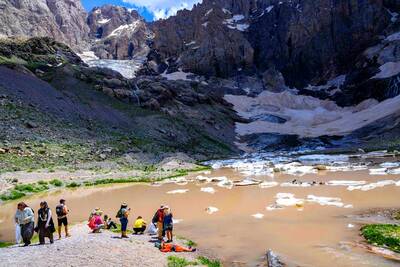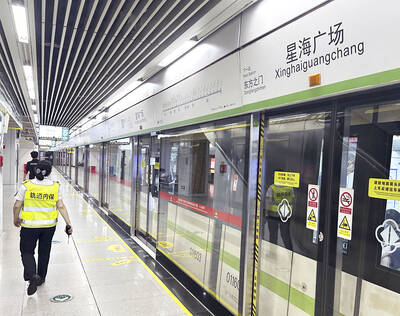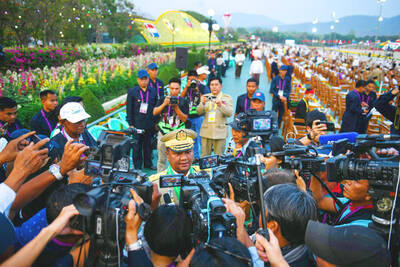Indonesia is hoping going nuclear can help it meet soaring energy demand while taming emissions, but faces serious challenges to its goal of a first small modular reactor by 2032.
Its first experiment with nuclear energy dates to February 1965, when then-Indonesian president Sukarno inaugurated a test reactor.
Sixty years later, Southeast Asia’s largest economy has three research reactors, but no nuclear power plants for electricity.

Photo: AFP
Abundant reserves of polluting coal have so far met the enormous archipelago’s energy needs, but “nuclear will be necessary to constrain the rise of and eventually reduce emissions,” said Philip Andrews-Speed, a senior research fellow at the Oxford Institute for Energy Studies.
Indonesian President Prabowo Subianto has promised to ensure energy security while meeting a pledge to eliminate coal-powered electricity generation within 15 years.
Coal accounts for about two-thirds of electricity generation in Indonesia, which is targeting net zero by 2050.
The government wants 40 gigawatts to 54 gigawatts of the 400 gigawatts it projects would be generated nationwide by 2060 to come from nuclear.
It hopes to kick-start capacity with a reactor on Borneo “by 2030 or 2032,” Indonesian Minister of Energy and Mineral Resources Bahlil Lahadalia said.
It will be a small modular reactor, which has a lower capacity than traditional reactors, but is easier to assemble and transport.
The total number of plants planned has not been detailed, but the government has begun scouting locations — a challenge for a nation on the seismically active “Ring of Fire.”
“Currently, 29 potential locations have been identified for the construction of nuclear power plants,” National Energy Council Acting Secretary-General Dadan Kusdiana said.
The sites would also put facilities near energy-hungry mining sites.
While the disaster at the Fukushima Dai-ichi nuclear power plant in Japan has stalled nuclear progress in some parts of Asia, proponents say nuclear can be done safely in Indonesia.
“North Java, East Sumatra, West Kalimantan and Central Kalimantan are considered as low-risk zones,” said Andang Widi Harto, a nuclear engineering researcher at Yogyakarta University. “These low seismic risk regions also coincide with low volcanic risk regions.”
Nations from Vietnam to Belgium are also growing or retaining nuclear capacity as they struggle to meet net zero goals to combat climate change.
While Indonesia might not be alone in the nuclear pivot, it has little domestic expertise to draw on.
It would look abroad for help, said Kusdiana, citing “serious interest” from providers including Russia’s Rosatom, China’s CNNC and Candu Canada.
The Indonesian subsidiary of US company ThorCon is already seeking a license for an experimental “molten-salt reactor.”
It wants to use shipyards to build small reactors that would be towed to coastal or offshore locations and “ballasted” to the seabed.
Given the challenges, which also include connectivity issues, waste disposal and potential domestic opposition, some experts warn Indonesia’s nuclear timeline is overambitious.
“I would join others who are skeptical that Indonesia can deploy nuclear power at any significant scale in the next 10 years,” Andrews-Speed said.
Environmentalists would like to see Indonesia focus more on meeting its clean energy targets with renewable sources.
While hydroelectric accounts for more than 7 percent of Indonesia’s electricity generation, solar and wind contribute tiny amounts and could be significantly ramped up, experts say.
The government has not said how much it expects the nuclear ramp-up to cost, but Kusdiana says the money would be there.
“Various potential international investors ... have shown interest,” including Russia, the US, Denmark, South Korea and China, he said.

In the sweltering streets of Jakarta, buskers carry towering, hollow puppets and pass around a bucket for donations. Now, they fear becoming outlaws. City authorities said they would crack down on use of the sacred ondel-ondel puppets, which can stand as tall as a truck, and they are drafting legislation to remove what they view as a street nuisance. Performances featuring the puppets — originally used by Jakarta’s Betawi people to ward off evil spirits — would be allowed only at set events. The ban could leave many ondel-ondel buskers in Jakarta jobless. “I am confused and anxious. I fear getting raided or even

Kemal Ozdemir looked up at the bare peaks of Mount Cilo in Turkey’s Kurdish majority southeast. “There were glaciers 10 years ago,” he recalled under a cloudless sky. A mountain guide for 15 years, Ozdemir then turned toward the torrent carrying dozens of blocks of ice below a slope covered with grass and rocks — a sign of glacier loss being exacerbated by global warming. “You can see that there are quite a few pieces of glacier in the water right now ... the reason why the waterfalls flow lushly actually shows us how fast the ice is melting,” he said.

RISING RACISM: A Japanese group called on China to assure safety in the country, while the Chinese embassy in Tokyo urged action against a ‘surge in xenophobia’ A Japanese woman living in China was attacked and injured by a man in a subway station in Suzhou, China, Japanese media said, hours after two Chinese men were seriously injured in violence in Tokyo. The attacks on Thursday raised concern about xenophobic sentiment in China and Japan that have been blamed for assaults in both countries. It was the third attack involving Japanese living in China since last year. In the two previous cases in China, Chinese authorities have insisted they were isolated incidents. Japanese broadcaster NHK did not identify the woman injured in Suzhou by name, but, citing the Japanese

RESTRUCTURE: Myanmar’s military has ended emergency rule and announced plans for elections in December, but critics said the move aims to entrench junta control Myanmar’s military government announced on Thursday that it was ending the state of emergency declared after it seized power in 2021 and would restructure administrative bodies to prepare for the new election at the end of the year. However, the polls planned for an unspecified date in December face serious obstacles, including a civil war raging over most of the country and pledges by opponents of the military rule to derail the election because they believe it can be neither free nor fair. Under the restructuring, Myanmar’s junta chief Min Aung Hlaing is giving up two posts, but would stay at the